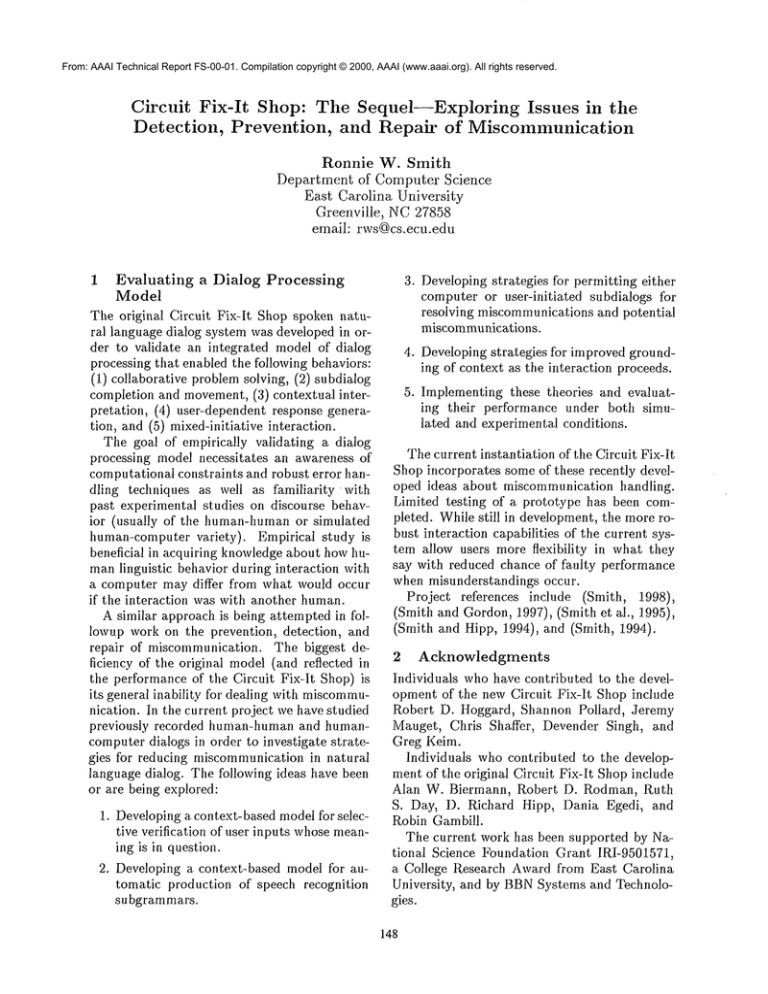
From: AAAI Technical Report FS-00-01. Compilation copyright © 2000, AAAI (www.aaai.org). All rights reserved.
Circuit Fix-It Shop: The Sequel Exploring Issues in the
Detection,
Prevention,
and Repair of Miscommunication
Ronnie W. Smith
Department of Computer Science
East Carolina University
Greenville, NC 27858
email: rws@cs.ecu.edu
1
Evaluating a Dialog Processing
Model
The original Circuit Fix-It Shop spoken natural language dialog system was developed in order to validate an integrated model of dialog
processing that enabled the following behaviors:
(1) collaborative problem solving, (2) subdialog
completion and movement,(3) contextual interpretation, (4) user-dependent response generation, and (5) mixed-initiative interaction.
The goal of empirically validating a dialog
processing model necessitates an awareness of
computational constraints and robust error handling techniques as well as familiarity with
past experimental studies on discourse behavior (usually of the human-humanor simulated
human-computer variety). Empirical study is
beneficial in acquiring knowledgeabout how humanlinguistic behavior during interaction with
a computer may differ from what would occur
if the interaction was with another human.
A similar approach is being attempted in followup work on the prevention, detection, and
repair of miscommunication. The biggest deficiency of the original model (and reflected in
the performance of the Circuit Fix-It Shop) is
its general inability for dealing with miscommunication. In the current project we have studied
previously recorded human-human and humancomputer dialogs in order to investigate strategies for reducing miscommunication in natural
language dialog. The following ideas have been
or are being explored:
1. Developing a context-based model for selective verification of user inputs whosemeaning is in question.
2. Developing a context-based model for automatic production of speech recognition
subgrammars.
.
Developing strategies for permitting either
computer or user-initiated
subdialogs for
resolving miscommunications and potential
miscommunications.
4. Developing strategies for improved grounding of context as the interaction proceeds.
5. Implementing these theories and evaluating their performance under both simulated and experimental conditions.
The current instantiation of the Circuit Fix-It
Shop incorporates some of these recently developed ideas about miscommunication handling.
Limited testing of a prototype has been cornpleted. While still in development, the more robust interaction capabilities of the current system allow users more flexibility
in what they
say with reduced chance of faulty performance
when misunderstandings occur.
Project references include (Smith, 1998),
(Smith and Gordon, 1997), (Smith et al., 1995),
(Smith and Hipp, 1994), and (Smith, 1994).
2
Acknowledgments
Individuals who have contributed to the development of the new Circuit Fix-It Shop include
Robert D. Hoggard, Shannon Pollard, Jeremy
Mauget, Chris Shaffer, Devender Singh, and
Greg Keim.
Individuals who contributed to the development of the original Circuit Fix-It Shop include
Alan W. Biermann, Robert D. Rodman, Ruth
S. Day, D. Richard Hipp, Dania Egedi, and
Robin Gambill.
The current work has been supported by National Science Foundation Grant IRI-9501571,
a College Research Award from East Carolina
University, and by BBNSystems and Technologies.
148
References
R.W. Smith and S.A. Gordon. 1997. Effects
of variable initiative on linguistic behavior in
human-computer spoken natural language dialog. Computational Linguistics, 23:141-168.
R.W. Smith and D.R. Hipp. 1994. Spoken
Natural Language Dialog Systems: A Practical Approach. Oxford University Press; New
York.
R.W. Smith, D.R. Hipp, and A.W. Biermann.
1995. An architecture for voice dialog systems based on Prolog-style theorem-proving.
Computational Linguistics, 21:281-320.
R.W. Smith. 1994. Spoken variable initiative
dialog: An adaptable natural-language interface. IEEEExpert, 9(1):45-50, February.
R.W. Smith. 1998. An evaluation of strategies for selectively verifying utterance meanings in spoken natural language diMog. International Journal of Human-Computer Studies, 48:627-647. (A preliminary version of
this work appeared in the Proceedings of the
Fifth Conference on Applied Natural Language Processing, pages 41-48, April 1997).
149


